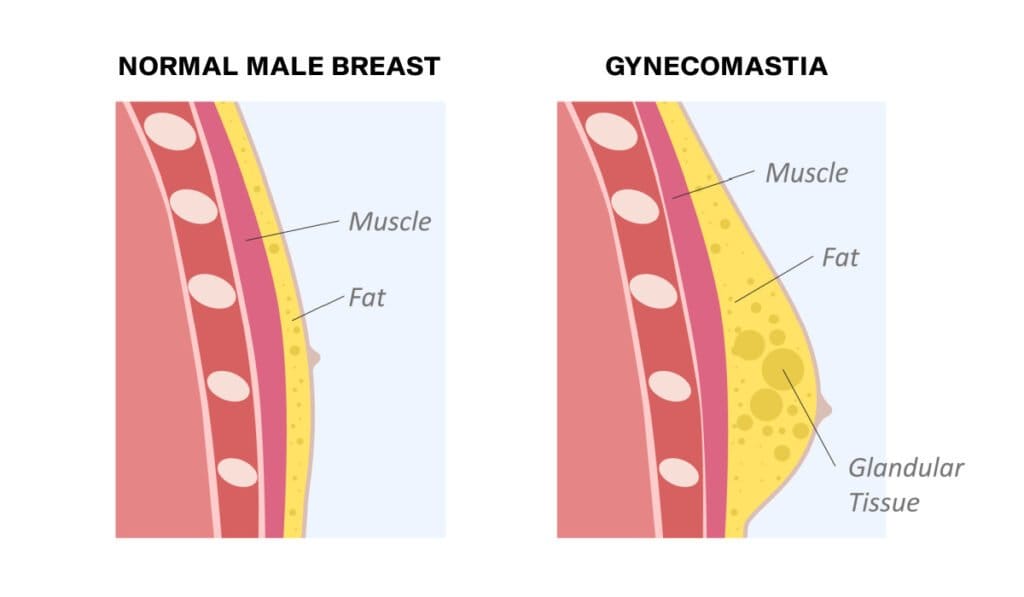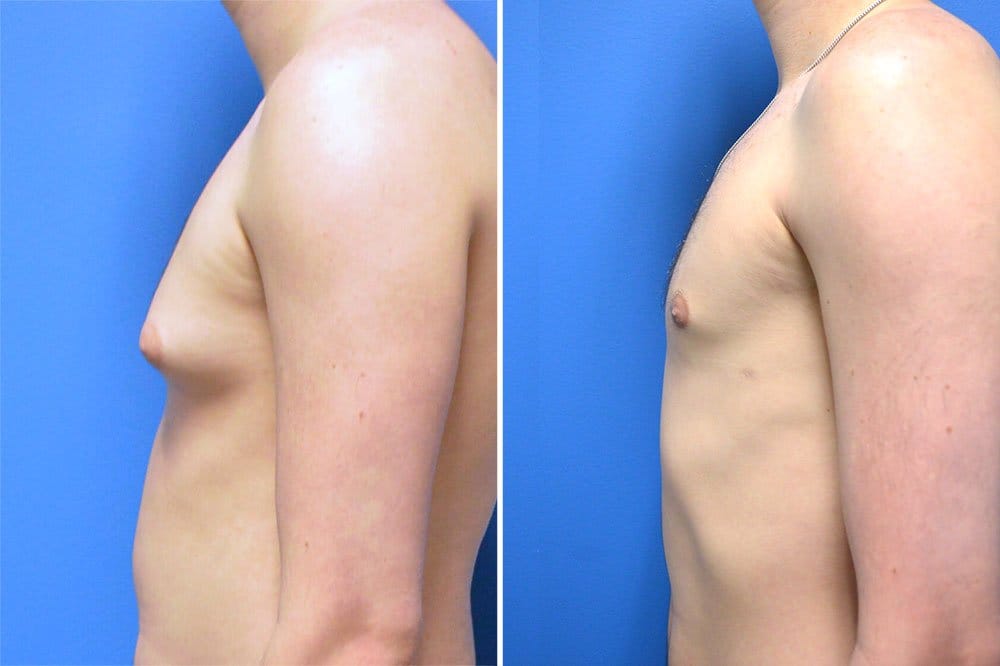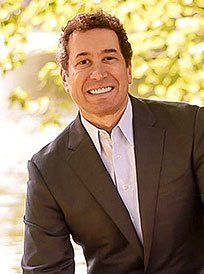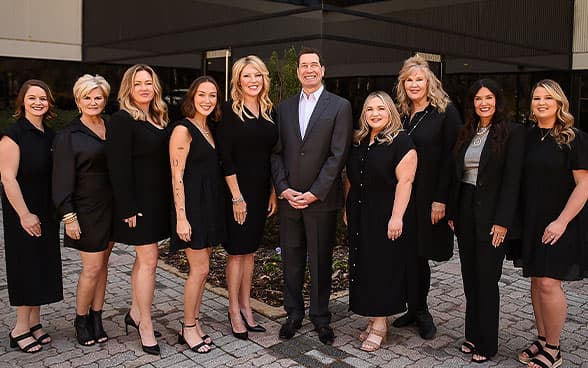Male Breast Reduction
Achieve a flatter, firmer, more masculine chest
Gynecomastia, a condition of enlarged male breasts, affects about half the male population to some extent. The cause varies and for the most part is unknown. The condition has been linked to hormonal issues, dietary issues, and certain types of drug use. No matter the cause, board certified Little Rock cosmetic surgeon Dr. Rhys Branman can sculpt a more masculine looking chest.

Do you have gynecomastia (Male EBT™)?
Gynecomastia can be caused by excess glandular tissue or excess fat. Most men present with a combination of both excess fat and glandular tissue, in some unique proportion. This condition is called Male EBT™, or Male Excess Breast Tissue. If you have had little-to-no success achieving a flatter, firmer chest with diet and exercise, it is likely that Male EBT™ is to blame—losing weight cannot influence excess glandular tissue. And, in many cases, weight loss does not achieve the level of fat reduction in the chest that a man would like to see.

If you think you have gynecomastia, male breast reduction surgery with a qualified surgeon is a safe, effective option to help you achieve a flatter, more masculine chest and feel more confident in your appearance.
- Learn even more! View Branman’s previous male breast reduction discussion on KATV’s Good Morning Arkansas below:
Dr. Branman talks gynecomastia on KATV
TRTMI™ Male Breast Reduction: Less Downtime, Virtually Invisible Scars
One of the main reasons men put off having male breast reduction is a fear of visible scars. Understandably, you wouldn’t want anyone who sees you shirtless to suspect you had surgery. Another challenge is the downtime—few men can afford to take even a week away from work to recover from surgery.
Dr. Branman understands these concerns and has developed an advanced technique that dramatically reduces both downtime and scarring: Tissue Removal Through Minimal Incisions, or TRTMI™.
Unlike traditional male breast reduction where tissue is removed with a scalpel, TRTMI™ (pronounced “treat-me”) removes both fat and glandular tissue using very thin microsurgery instruments. This allows Dr. Branman to address Male EBT™ and sculpt an improved chest shape through tiny incisions (less than 1 cm) while also minimizing impact on surrounding tissues.
Our TRTMI™ patients are typically back to work within a couple of days—often after a long weekend—and experience considerably less bruising, swelling, and discomfort after surgery.

Your Male Breast Reduction Surgery
Once we determine the composition of the breast tissue, we can design an effective treatment plan. Whenever possible, Dr. Branman will use the TRTMI technique to remove the excess breast tissue. He will work to create a flat, smooth surface with no dips and rises. Most procedures take about 90 minutes, although some are longer.
When surgery is finished, the skin will be stitched to its new position and a dressing applied. There may be dissolvable stitches below the skin as part of the sculpturing of your new shape.
In certain cases, where a patient has severe Male EBT™ and/or sagging skin to address, Dr. Branman may need to use slightly longer incisions and traditional tissue excision to achieve a satisfying result. Even in these cases, he will take care to place incisions in natural contours of the body, such as the edge of the areola.
Preparing for Surgery, Post-Op, and Complications to Watch For
In this video, our Registered Nurse details the process of a gynecomastia treatment here at Cosmetic Surgery Center in Little Rock. She covers what you’ll need for the procedure, how to prepare for surgery, what to expect when recovering at home, and complications to keep an eye out for.
Video Transcript »
Hey y’all, Registered Nurse here at CSC. Today we’re going to talk about gynecomastia surgery. If you haven’t already watched the general surgery information video, make sure to do that first, as it contains important details for any surgery.
Here’s what you’ll need for this procedure: your lab work and prescription medications, which you’ll get at your pre-op appointment. You’ll also need Johnson & Johnson surgical dressing pads or something similar; feminine maxi pads can work in a pinch. Additionally, have hydrogen peroxide, distilled water, and Q-tips ready to clean your incision sites.
Remember to wear a loose, button-up or zip-up top to your surgery. We’ve covered this in the general surgery information video, but it’s worth repeating so that when you go home in your vest (which we’ll put on you after surgery), your clothing will fit comfortably underneath.
You’ll need to restart your antibiotic and Sinec medication when you get home, taking them with a light meal or some crackers and Gatorade to help avoid nausea. For the first two days post-surgery, sleep in a semi-sitting position. This can be propped up on pillows in bed, in a bed that inclines, or even in a recliner—whatever is most comfortable for you.
Your first post-op appointment will typically be a week after surgery, unless you had significant breast tissue removal or a more involved procedure, in which case you may need to see us sooner. When you take your first shower, usually the day after surgery (unless you need to come in to see us that day), let the water trickle down over your chest without directly hitting your incision sites. If you have strong water pressure, try turning around to let the water run down gently.
If you have white tape over your incisions, leave it on until we remove it at your follow-up appointment. If the tape starts to peel off after a shower, pat it down with a dry washcloth, and use a cool setting on a blow dryer to help it stick. Never use heat. If the tape won’t stay, give us a call, and we can replace it. After showering, cover your incisions with dressing pads and put your vest back on.
Sometimes, Dr. Branman may recommend an additional week of tape, depending on the extent of tissue removal and how your swelling is doing. For four weeks after surgery, avoid any lifting, pushing, pulling, or strenuous activity. No lifting more than 10 pounds in the first week, and no more than 20 pounds for the following three weeks.
If you experience significant pain, swelling around the collarbone, or deep purple bruising on your chest, call us immediately. Avoid direct sun exposure to your incision sites for six to twelve months, as it can cause darkening. Wear sunscreen or a shirt to protect the area.
You can start driving again 72 hours after surgery if you’re no longer taking pain medication and feel comfortable enough to use your chest muscles to drive. Remember, it can take six months to a year for your chest to fully settle into its final appearance, so be patient.
No tub baths, hot tubs, lakes, or oceans for four to six weeks—showers only. If you don’t have white tape on your chest and just have Steri-Strips, you’ll start cleaning the incisions when Dr. Branman gives you the okay, usually after five days. If you’re unsure whether to start cleaning, call us for clarification.
You’ll wear a compression vest for about two weeks after surgery. This vest helps manage swelling and improve your results. Keep it on at all times unless you’re showering or washing the vest. Put it back on immediately after.
If you have any questions or concerns, don’t hesitate to call us. Thanks for watching, and we can’t wait to see you at your pre-op!
How long is recovery after male breast reduction?
It may take a few months for the results of male breast reduction to be fully appreciated. Dr. Branman will provide instructions on how to care for yourself after the surgery. To reduce recovery time and the risk of complications, these instructions should be closely followed. Swelling, bruising, and some discomfort should be expected after male breast reduction—although these side effects are usually much less pronounced and shorter-lived with Dr. Branman’s TRTMI™ technique, a huge benefit for his patients.
Once healing is complete, you should be able to appreciate a flatter, firmer, more masculine chest.
“I was embarrassed and vulnerable about my body and from the moment I stepped into the clinic, I felt comfortable. Everyone treated me with kindness and respect, and I never felt ashamed. The whole procedure from scheduling to post-op care was well-organized and I felt like all my answers were answered in a timely manner.”
- Key Benefits
- Glossary
- Flatter, more masculine chest: Removes excess fat and glandular tissue, creating a firmer and more contoured chest.
- Natural-looking results: Achieves subtle, natural contours that blend with your body for a balanced and proportionate appearance.
- Adipose Tissue: Body fat that can accumulate in the chest area, contributing to the appearance of gynecomastia. Often targeted during surgery for removal.
- Anesthesia: Medication administered to prevent pain during surgery, either local or general, depending on the extent of the procedure.
- Areola: The pigmented area surrounding the nipple, which may be reshaped or resized during gynecomastia surgery to create a more masculine chest appearance.
- Asymmetry: A condition where one side of the chest may appear larger or more pronounced than the other. Gynecomastia surgery aims to correct this imbalance.
- Compression Garments: Special clothing worn after surgery to reduce swelling, promote healing, and help skin conform to the new chest contours.
- Drains: Small tubes that may be placed after surgery to remove excess fluid from the surgical site and promote healing.
- Endocrinology: The branch of medicine that deals with hormones. Hormonal imbalances are a common cause of gynecomastia, and an endocrinologist may be consulted before surgery.
- Excess Fat: Localized fat deposits in the chest area, which can be removed during male breast reduction to create a flatter, firmer chest.
- Excision: A surgical technique used to remove glandular breast tissue and excess skin during gynecomastia surgery.
- Fibrous Tissue: A type of dense, firm tissue that can contribute to gynecomastia. It is often removed through excision during male breast reduction surgery.
- Glandular Tissue: Firm, dense breast tissue that can develop in men due to hormonal imbalances, often necessitating surgical removal in gynecomastia treatment.
- Gynecomastia: The enlargement of male breast tissue, often caused by hormonal imbalance, weight gain, or genetics. Surgery can reduce the size of the chest and improve its appearance.
- Hormonal Imbalance: A common underlying cause of gynecomastia, where elevated levels of estrogen or decreased testosterone can lead to the development of breast tissue in men.
- Incision: A surgical cut made during gynecomastia surgery, typically placed around the areola or in the chest fold to minimize visible scarring.
- Inframammary Fold: The natural crease under the chest, where incisions may be made during gynecomastia surgery to help hide scarring.
- Keloids: Raised, thickened scars that may develop in some individuals after surgery. Special scar treatments may be used to minimize keloid formation.
- Liposuction: A common cosmetic procedure often used in gynecomastia surgery to remove excess fat in the chest area for a more masculine contour.
- Male Breast Reduction: The surgical procedure performed to treat gynecomastia, which involves removing excess fat, glandular tissue, and sometimes skin.
- Postoperative Recovery: The period after surgery when the body heals. Rest, compression garments, and follow-up care are essential to a smooth recovery.
- Pseudogynecomastia: A condition where the chest enlargement is due to fat accumulation rather than glandular tissue, which can often be treated with liposuction alone.
- Scarring: Marks left on the skin after surgery, typically minimal and placed in inconspicuous areas. Surgeons aim to reduce visible scarring as much as possible.
- Sutures: Stitches used to close incisions after gynecomastia surgery, helping the skin heal and minimizing the risk of scarring.
- Tissue Resection: The removal of excess breast tissue in men, which is often necessary to treat moderate to severe gynecomastia.
- Ultrasound-Assisted Liposuction (UAL): A type of liposuction that uses ultrasound technology to break up fat before removing it, often used in male breast reduction to enhance precision.

If you have questions or would like to learn more about your options for addressing excess male breast tissue, or other cosmetic surgery procedures for men, we are here to help. Dr. Branman has been helping Little Rock gynecomastia patients since 1998 meet their cosmetic goals, and he would be happy for you to come in for a consultation. Contact us to schedule a consultation with award-winning cosmetic surgeon Dr. Rhys Branman at our cosmetic surgery center in Little Rock, AR.
